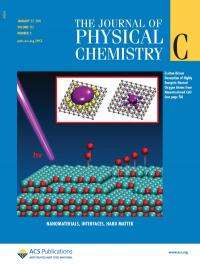Exciting atoms on the move: Fine-tuned laser light activates oxygen atoms to escape the surface

(PhysOrg.com) -- A new way to accelerate and remove oxygen atoms from thin films of calcium oxide has been discovered by a team of scientists from Pacific Northwest National Laboratory, University College of London, and Tohoku University. By choosing the appropriate laser wavelength, they found a way to remove oxygen at many times the speed of sound. The atoms escape from the surface of nanostructured films of calcium oxide.
This research has implications for research and development in photochemistry, catalysis, and microelectronics. It was chosen as the cover of The Journal of Physical Chemistry C for January 27, 2011.
Focusing on new and old questions, basic research helps us understand the pure principles of science and provides the building blocks for solving big scientific problems. In this new research, a team of materials and theoretical physicists collaborated to answer questions about gaining greater control over thin film structures. Thin films are important for research in photochemistry, catalysis, and microelectronics, and have applications in industries such as pharmaceuticals and energy technologies.
This project involves desorption of neutral oxygen atoms from a thin film of calcium oxide (CaO). Desorption is the process of removing atoms or other particles from a surface. By shining an ultraviolet-laser on the high-surface-area material, neutral oxygen atoms are desorbed at several times the speed of sound.
Researchers used a technique developed at PNNL called reactive ballistic deposition to grow a nanostructured film of CaO. Using laser pulses to excite the film, researchers applied time-of-flight techniques to measure the kinetic energy and yield of desorbed oxygen atoms. By selecting the laser wavelength, they were able to produce highly energetic atoms from the film surface. The electronic excitation, known as exciton, is initially formed in the material's bulk. Excitons are mobile and can transfer electronic energy to the surface of the film. Once on the surface, some of the exciton energy is channeled into desorption of neutral oxygen atoms at high speed.
This research shows that it is possible to manipulate particular molecular structures on a material surface by tuning the laser wavelength. This discovery could be useful for manipulating surface structures at the atomic level. Modifying thin films on a very fine scale may allow scientists better control over thin film structures.
Researchers continue to work on developing and exploring other mechanisms for thermal desorption processes from oxide materials.
More information: Sushko PV, AL Shluger, AG Jolly, KM Beck, and WP Hess. 2011. "Exciton-Driven Highly Hyperthermal O-Atom Desorption from Nanostructured CaO." Journal of Physical Chemistry C, 115 (3), 692-699. DOI:10.1021/jp1078423 . December 9, 2010
Provided by Pacific Northwest National Laboratory



















